Extreme Heavy Rainfall Events at Mid-Latitudes as the Outcome of a Slow Quasi-Resonant Ocean—Atmosphere Interaction: 10 Case Studies
Abstract
:1. Introduction
2. Materials and Methods
2.1. Data
2.2. Decomposition of SST and Preciptation Data in Period Ranges
2.3. Morlet Wavelet Analysis
2.4. Coherence and Phase of Rainfall and SST Anomalies According to Harmonic Modes
2.4.1. Exceptional Rainfall Episodes in Characteristic Period Ranges
2.4.2. Exceptional Rainfall Amount for One Day
3. Results
3.1. SST Anomalies That Fuel the Heavy Rainfall Are Developing along an Eastern Boundary Current
3.1.1. A Demonstrative Case Study: The Extreme Precipitation Events That Occurred in Western and Northern Europe in June 2016
Evolution of Rainfall Anomalies in Characteristic Period Ranges
Co-Evolution of SST and Rainfall Anomalies in Characteristic Period Ranges
3.1.2. Extreme Precipitation in June 2005, in Alberta, Canada
Evolution of 1/384 and 1/192 Harmonics of Precipitation
Co-Evolution of SST and Rainfall Anomalies in Characteristic Period Ranges
3.2. SST Anomalies That Fuel the Heavy Rainfall Are Developing along a Western Boundary Current
3.2.1. Extreme Precipitation in July 2012, in Japan
Evolution of 1/384 and 1/192 Harmonics of Precipitation
Co-Evolution of SST and Rainfall Anomalies in Characteristic Period Ranges
3.2.2. Extreme Precipitation in June 2020, China
Evolution of 1/384 and 1/192 Harmonics of Precipitation
Co-Evolution of SST and Rainfall Anomalies in Characteristic Period Ranges
3.2.3. Extreme Precipitation in August 2015, Argentina
Evolution of 1/384 and 1/192 Harmonics of Precipitation
Co-Evolution of SST and Rainfall Anomalies in Characteristic Period Ranges
3.2.4. Extreme Precipitation in February 2007, Mozambique
Evolution of 1/384 and 1/192 Harmonics of Precipitation
Co-Evolution of SST and Rainfall Anomalies in Characteristic Period Ranges
3.2.5. Extreme Precipitation in January 2011, in Victoria, Australia
Evolution of 1/384 and 1/192 Harmonics of Precipitation
Co-Evolution of SST and Rainfall Anomalies in Characteristic Period Ranges
3.2.6. Extreme Precipitation in February 2020, in Kentucky, USA
Evolution of 1/384 and 1/192 Harmonics of Precipitation
Co-Evolution of SST and Rainfall Anomalies in Characteristic Period Ranges
3.2.7. Extreme Precipitation in August 2005, in Louisiana, USA
Evolution of 1/384 and 1/192 Harmonics of Precipitation
Co-Evolution of SST and Rainfall Anomalies in Characteristic Period Ranges
3.3. Extreme Precipitation in October–November 2011, in Mediterranean Countries
3.3.1. A Tropical-Like Storm
3.3.2. Extreme Precipitation in France, 4 November 2011
Evolution of 1/384 and 1/192 Harmonics of Precipitation
Co-Evolution of SST and Rainfall Anomalies in Characteristic Period Ranges
4. Discussion
4.1. SST Anomalies Develop along an Eastern Boundary Current
4.2. SST Anomalies Develop along a Western Boundary Current
4.3. SST Anomalies Develop in the Mediterranean Sea
4.4. Potential Link with Global Warming
5. Conclusions
Funding
Institutional Review Board Statement
Informed Consent Statement
Data Availability Statement
Acknowledgments
Conflicts of Interest
References
- Cotton, W.R.; Bryan, G.H.; van den Heever, S.C. Storm and Cloud Dynamics, International Geophysics; Elsevier: Amsterdam, The Netherlands, 2011; eBook; ISBN 9780080916651. [Google Scholar]
- Myhre, G.; Alterskjær, K.; Stjern, C.W.; Hodnebrog, Ø.; Marelle, L.; Samset, B.H.; Sillmann, J.; Schaller, N.; Fischer, E.; Schulz, M.; et al. Frequency of extreme precipitation increases extensively with event rareness under global warming. Sci. Rep. 2019, 9, 16063. [Google Scholar] [CrossRef] [PubMed]
- Sillmann, J.; Kharin, V.V.; Zwiers, F.W.; Zhang, X.; Bronaugh, D. Climate extremes indices in the CMIP5 multimodel ensemble: Part 2. Future climate projections. J. Geophys. Res. Atmos. 2013, 118, 2473–2493. [Google Scholar] [CrossRef]
- Giorgi, F.; Coppola, E.; Raffaele, F. A consistent picture of the hydroclimatic response to global warming from multiple indices: Models and observations. J. Geophys. Res. Atmos. 2014, 119, 11695–11708. [Google Scholar] [CrossRef]
- Lehmann, J.; Coumou, D.; Frieler, K. Increased record-breaking precipitation events under global warming. Clim. Change 2015, 132, 501–515. [Google Scholar] [CrossRef]
- Fischer, E.M.; Knutti, R. Detection of spatially aggregated changes in temperature and precipitation extremes. Geophys. Res. Lett. 2014, 41, 547–554. [Google Scholar] [CrossRef]
- van Oldenborgh, G.J.; Philip, S.; Aalbers, E.; Vautard, R.; Otto, F.E.L.; Haustein, K.; Habets, F.; Singh, R.; Cullen, H. Rapid attribution of the May/June 2016 flood-inducing precipitation in France and Germany to climate change. Hydrol. Earth Syst. Sci. 2016. [Google Scholar] [CrossRef]
- Dong, S.; Sun, Y.; Li, C.; Zhang, X.; Min, S.-K.; Kim, Y.-H. Attribution of Extreme Precipitation with Updated Observations and CMIP6 Simulations. J. Clim. 2021, 34, 871–881. [Google Scholar] [CrossRef]
- Sun, Q.; Zhang, X.; Zwiers, F.; Westra, S.; Alexander, L.V. A Global, Continental, and Regional Analysis of Changes in Extreme Precipitation. J. Clim. 2021, 34, 243–258. [Google Scholar] [CrossRef]
- The July 2021 Floods in Germany and the Climate Crisis—A Statement by Members of Scientists for Future. Available online: https://info-de.scientists4future.org/the-july-2021-floods-in-germany-and-the-climate-crisis/ (accessed on 2 January 2023).
- Ferreira, R. Cut-Off Lows and Extreme Precipitation in Eastern Spain: Current and Future Climate. Atmosphere 2021, 12, 835. [Google Scholar] [CrossRef]
- Messori, G.; Bevacqua, E.; Caballero, R.; Coumou, D.; de Luca, P.; Faranda, D.; Kornhuber, K.; Martius, O.; Pons, F.; Raymond, C.; et al. Compound climate events and extremes in the mid-latitudes: Dynamics, simulation and statistical characterization. Bull. Am. Meteorol. Soc. 2021, 102, E774–E781. [Google Scholar] [CrossRef]
- Sea Level Anomaly and Geostrophic Currents, Multi-Mission, Global, Optimal Interpolation, Gridded, Provided by the National Oceanic and Atmospheric Administration (NOAA). Available online: https://coastwatch.noaa.gov/pub/socd/lsa/rads/sla/daily/nrt/ (accessed on 19 November 2021).
- Daily Sea Surface Temperature Is Provided by NOAA. Available online: https://www.ncei.noaa.gov/data/sea-surface-temperature-optimum-interpolation/v2.1/access/avhrr/ (accessed on 8 January 2022).
- Reynolds, R.W.; Smith, T.M.; Liu, C.; Chelton, D.B.; Casey, K.S.; Schlax, M.G. Daily High-Resolution-Blended Analyses for Sea Surface Temperature. J. Clim. 2007, 20, 5473–5496. [Google Scholar] [CrossRef]
- Banzon, V.; Smith, T.M.; Chin, T.M.; Liu, C.; Hankins, W. A long-term record of blended satellite and in situ sea-surface temperature for climate monitoring, modeling and environmental studies. Earth Syst. Sci. Data 2016, 8, 165–176. [Google Scholar] [CrossRef]
- Huang, B.; Liu, C.; Banzon, V.; Freeman, E.; Graham, G.; Hankins, B.; Smith, T.; Zhang, H.M. Improvements of the Daily Optimum Interpolation Sea Surface Temperature (DOISST) Version v2.1. J. Clim. 2021, 34, 2923–2939. [Google Scholar] [CrossRef]
- Temperature and Precipitation Gridded Data for Global and Regional Domains Derived from In-Situ and Satellite Observations, Provided by Copernicus. Available online: https://cds.climate.copernicus.eu/cdsapp#!/dataset/insitu-gridded-observations-global-and-regional?tab=formhttps://climate.copernicus.eu/esotc/2020/precipitations (accessed on 2 January 2023).
- Pinault, J.-L. Morlet Cross-Wavelet Analysis of Climatic State Variables Expressed as a Function of Latitude, Longitude, and Time: New Light on Extreme Events. Math. Comput. Appl. 2022, 27, 50. [Google Scholar] [CrossRef]
- Torrence, C.; Compo, G.P. A Practical Guide to Wavelet Analysis. Bull. Am. Meteorol. Soc. 1998, 79, 61–78. [Google Scholar] [CrossRef]
- Pinault, J.-L. Regions Subject to Rainfall Oscillation in the 5–10 Year Band. Climate 2018, 6, 2. [Google Scholar] [CrossRef]
- Pinault, J.-L. Global warming and rainfall oscillation in the 5–10 yr band in Western Europe and Eastern North America. Clim. Chang. 2012, 114, 621–650. [Google Scholar] [CrossRef]
- Flooding in Alberta in 2005—An Overview. Available online: https://www.alberta.ca/release.cfm?xID=199938B24A678-B403-7562-2D1B4A3C14E15A79 (accessed on 11 November 2022).
- Haeseler, S. Heavy Rains on Kyushu/Japan in July 2012. Available online: https://www.dwd.de/EN/ourservices/specialevents/precipitation/20120801_Kyushu_en.pdf?__blob=publicationFile&v=3 (accessed on 11 November 2022).
- Extreme Rainfall in East Asia—Summer 2020, Met Office. Available online: https://www.metoffice.gov.uk/research/approach/collaboration/newton/insights/china---summer-2020-flooding (accessed on 11 November 2022).
- Clark, R.T.; Dong, X.; Ho, C.-H.; Sun, J.; Yuan, H.; Takemi, T. Special Issue on Summer 2020: Record Rainfall in Asia—Mechanisms, Predictability and Impacts. Adv. Atmos. Sci. 2021, 38, 12. [Google Scholar] [CrossRef]
- Argentina Flooding Kills Three, Leads to Thousands Evacuating Homes, ABC News. 12 August 2015. Available online: https://www.abc.net.au/news/2015-08-12/argentina-flooding-sparks-evacuation-of-thousands/6692118 (accessed on 11 November 2022).
- Cyclone Favio Floods Mozambique, National Aeronautics and Space Administration (NASA). Available online: https://earthobservatory.nasa.gov/images/18053/cyclone-favio-floods-mozambique (accessed on 11 November 2022).
- Hundreds Evacuated as Floods Threaten Victoria, ABC News, 14 January 2011. Available online: https://www.abc.net.au/news/2011-01-14/hundreds-evacuated-as-floods-threaten-victoria/1905122 (accessed on 11 November 2022).
- Major Flooding Inundates Southeast Kentucky Followed by Light Snow from 6–7 February 2020, National Oceanic and Atmospheric Administration (NOAA). Available online: https://www.weather.gov/jkl/20200206_floodsnow (accessed on 11 November 2022).
- Hurricane Katrina, Britannica. Available online: https://www.britannica.com/event/Hurricane-Katrina (accessed on 11 November 2022).
- Pytharoulis, I.; Kartsios, S.; Tegoulias, I.; Feidas, H.; Miglietta, M.M.; Matsangouras, I.; Karacostas, T. Sensitivity of a Mediterranean Tropical-Like Cyclone to Physical Parameterizations. Atmosphere 2018, 9, 436. [Google Scholar] [CrossRef] [Green Version]
- Kerkmann, J.; Bachmeier, S. Development of a tropical storm in the Mediterranean Sea (6-9 November 2011), EUMETSAT. Available online: https://www.eumetsat.int/tropical-storm-develops-mediterranean-sea#:~:text=Overall%2C%20the%20tropical%20storm%20caused,six%20Italians%20and%20five%20French (accessed on 11 November 2022).

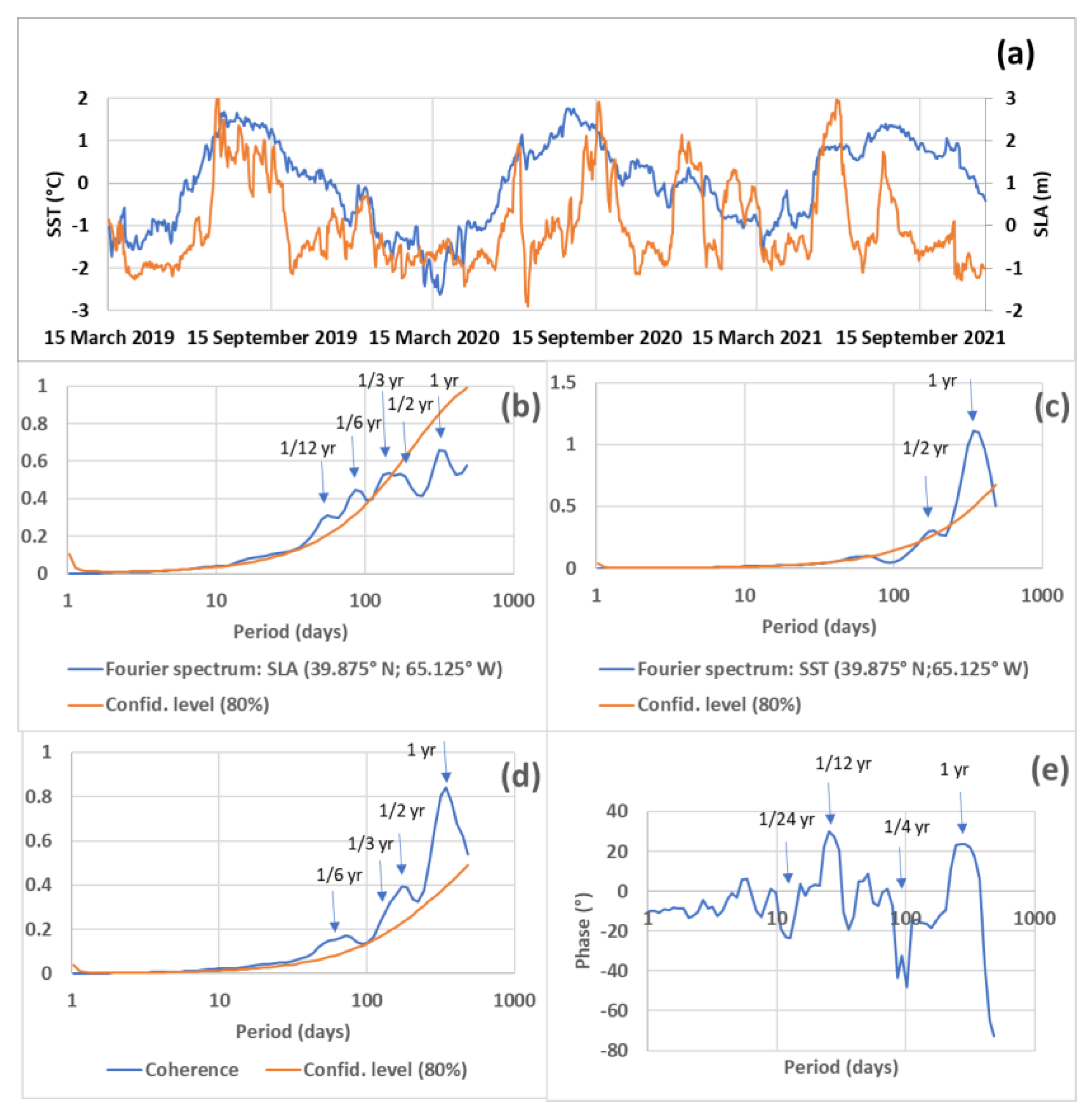
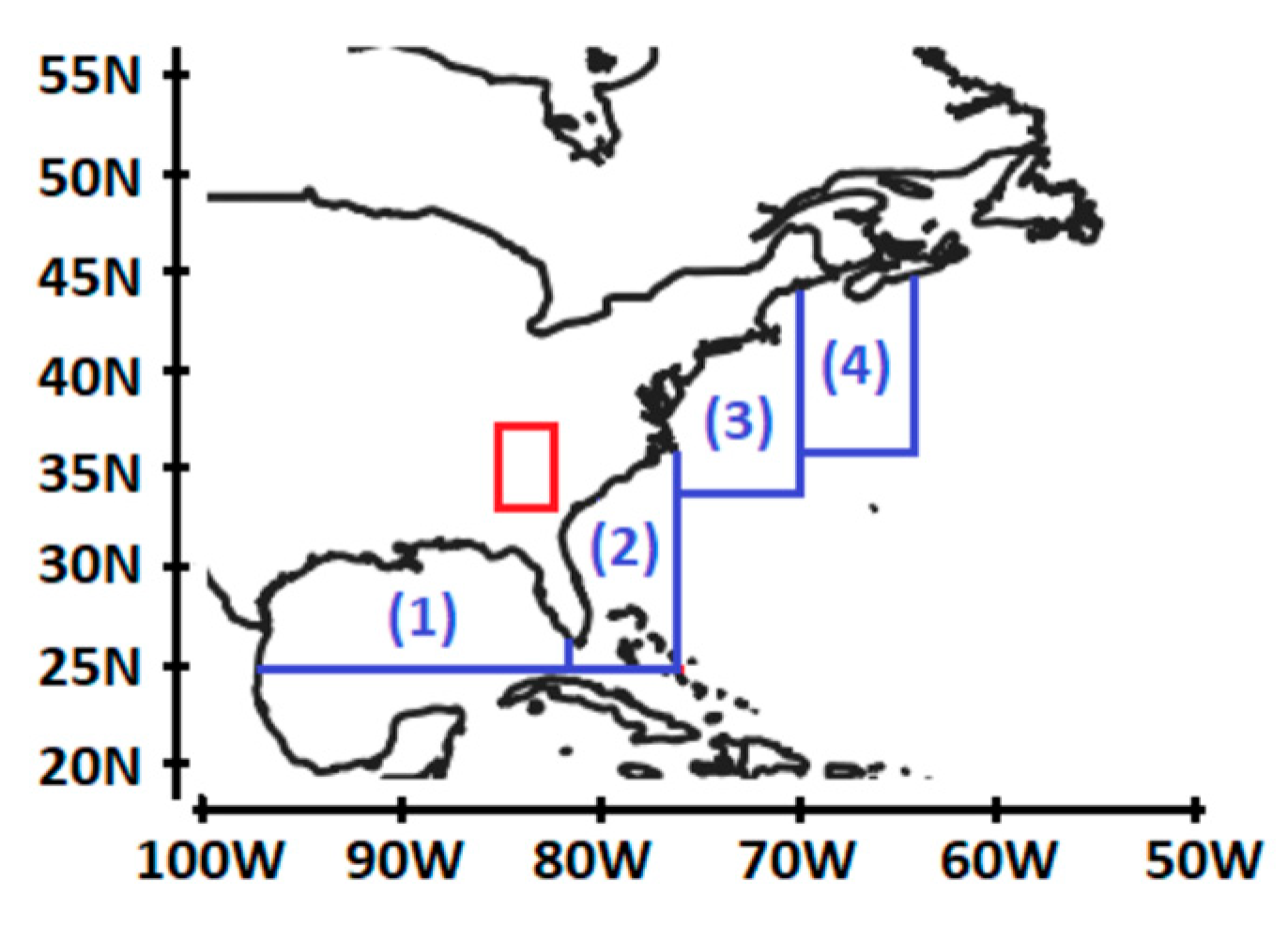

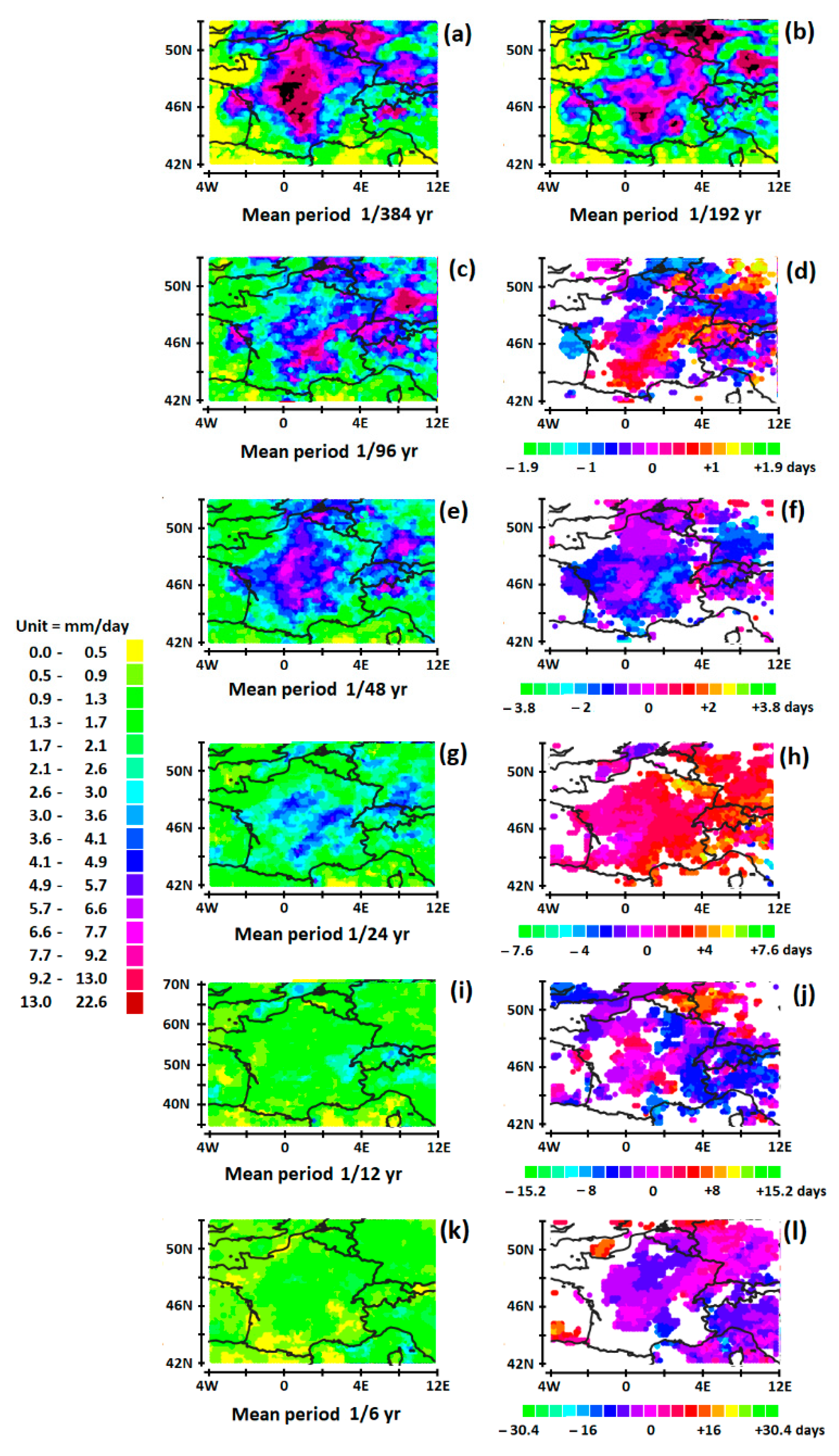
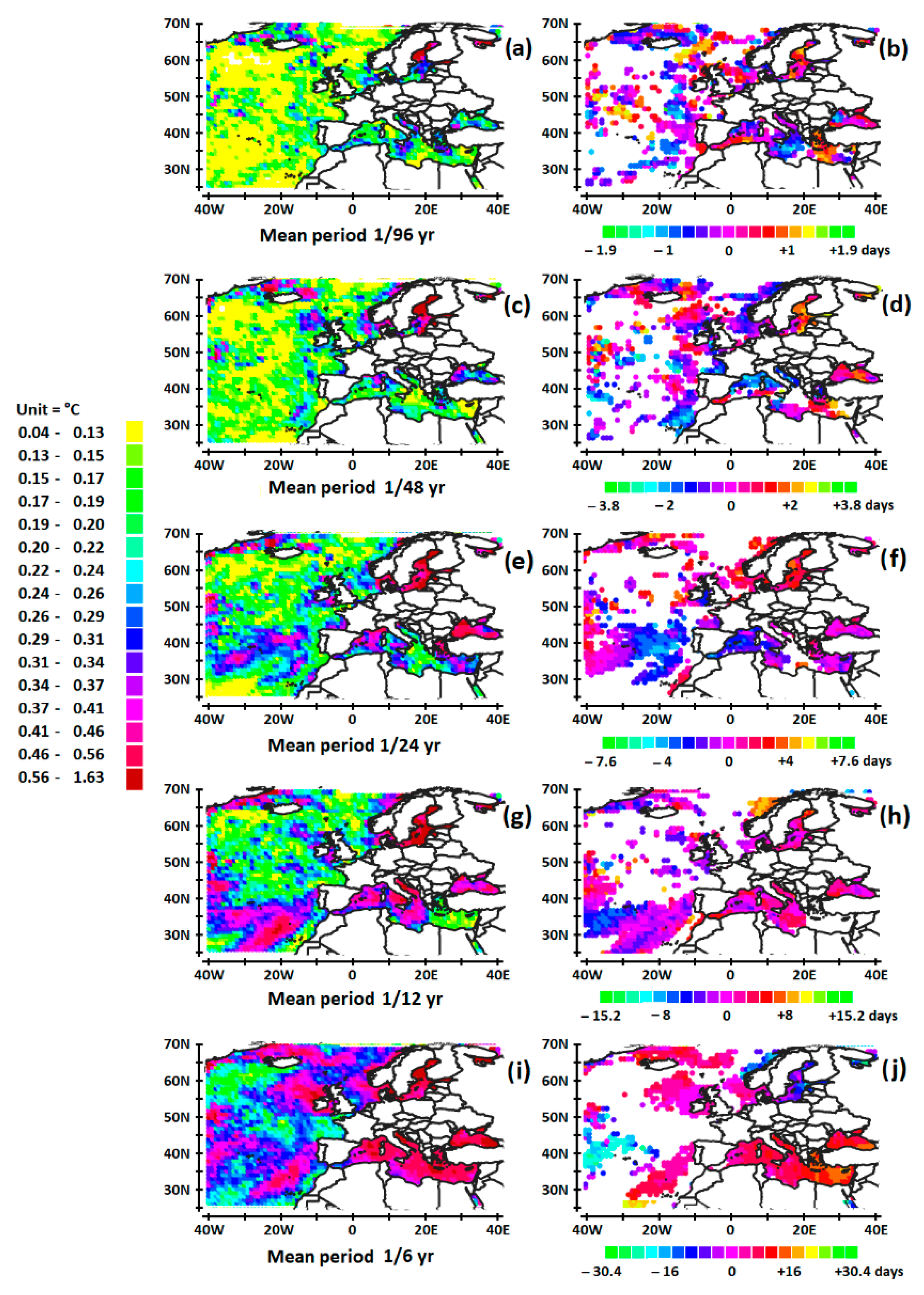

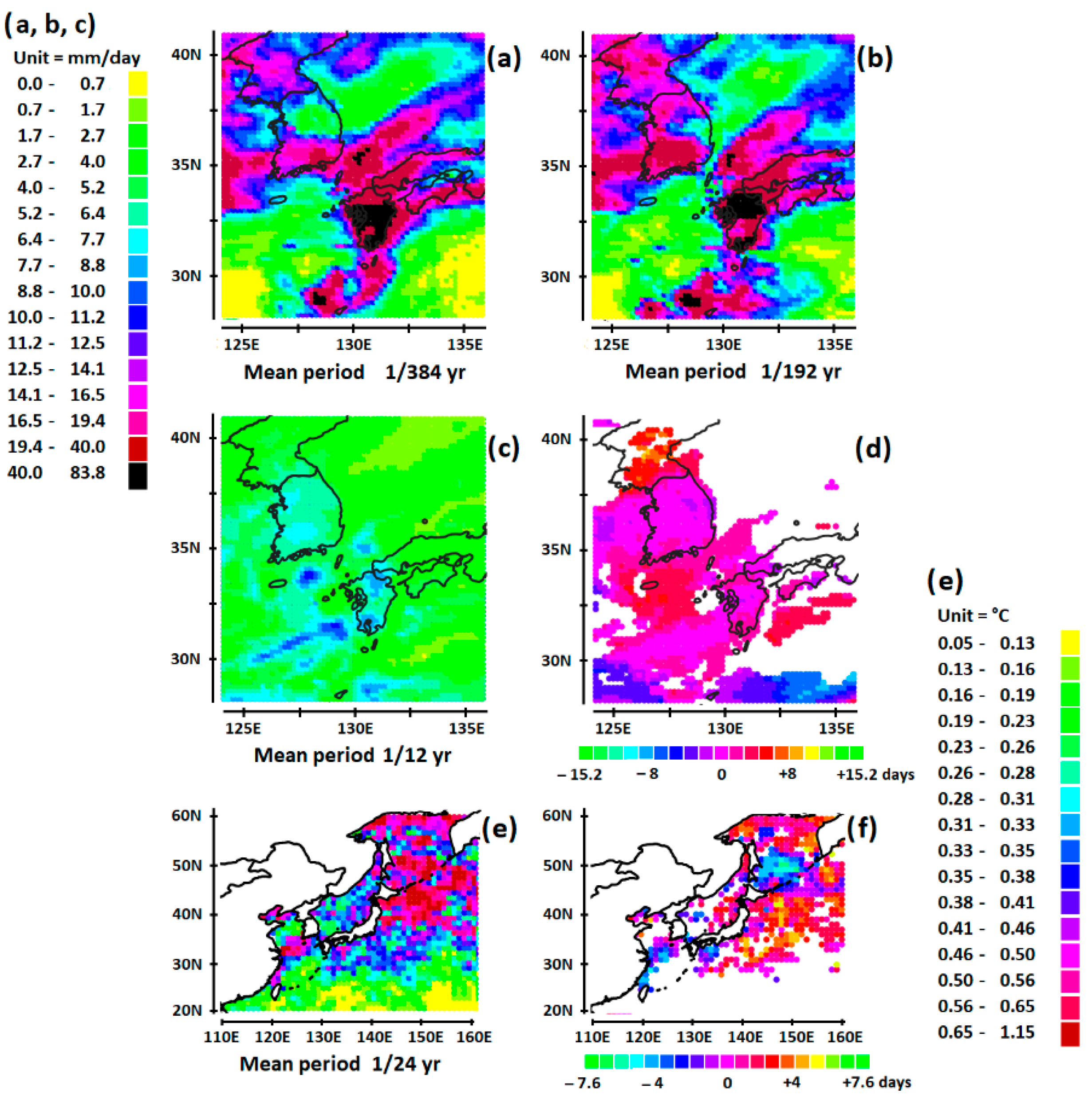
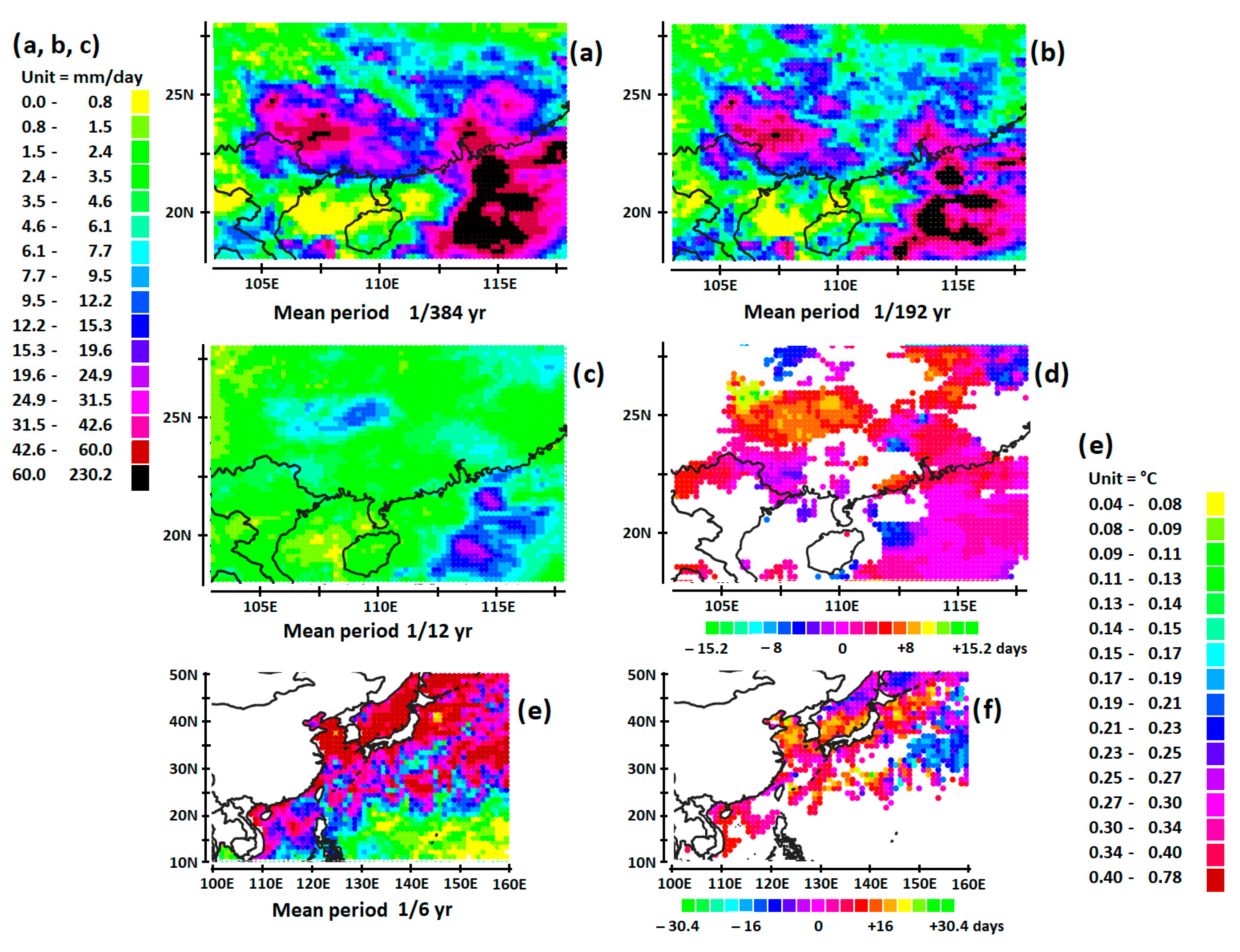
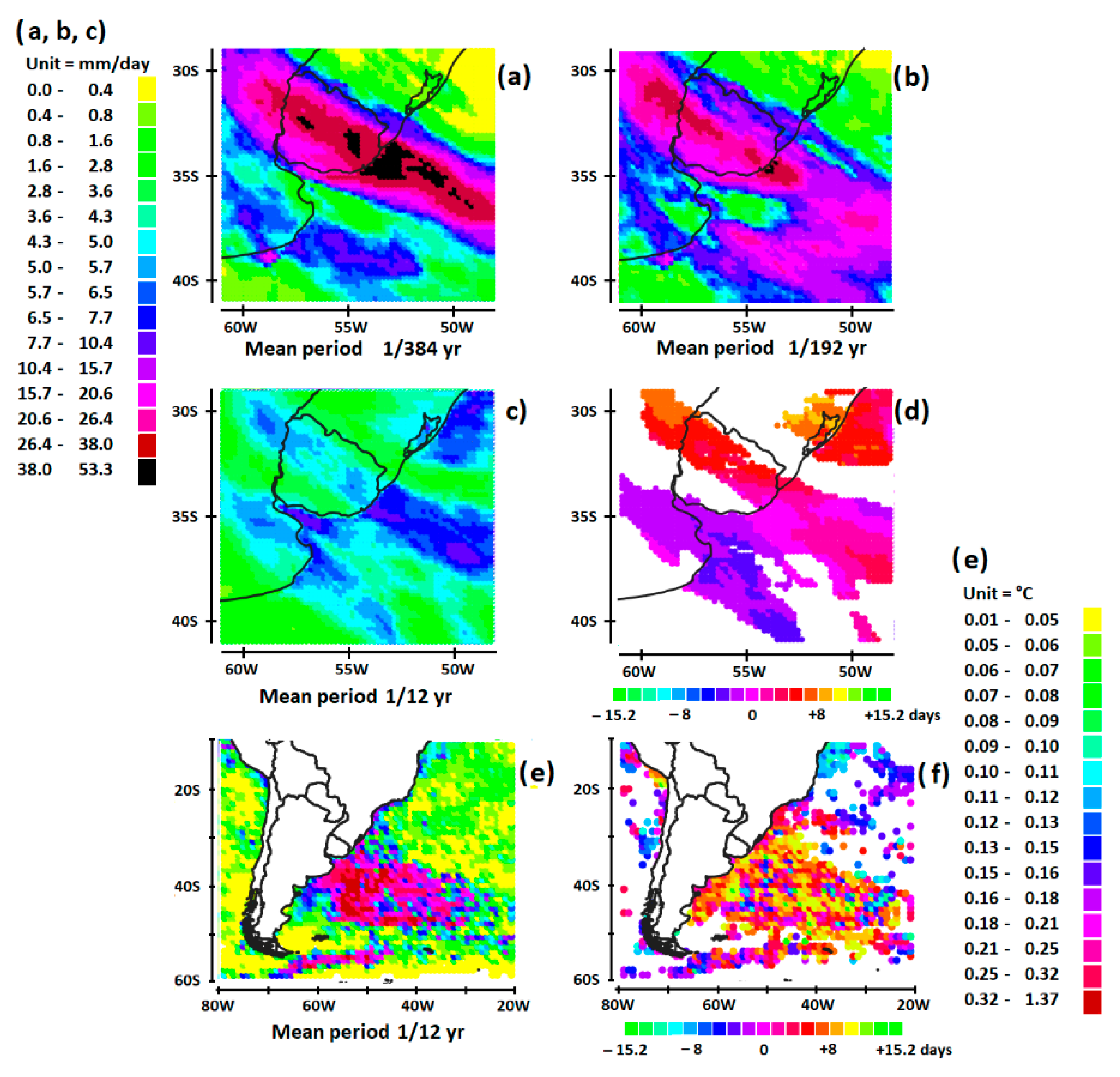
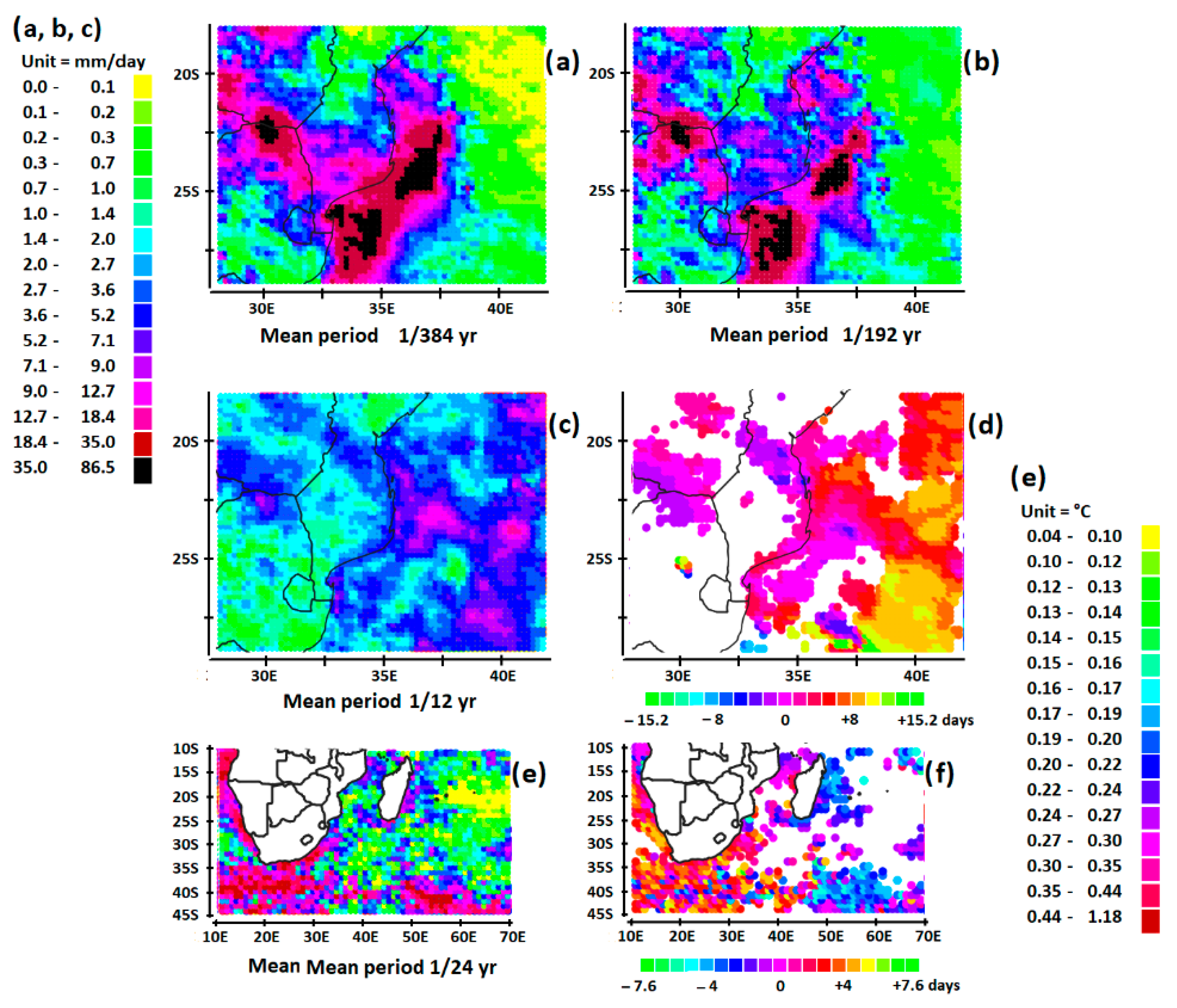
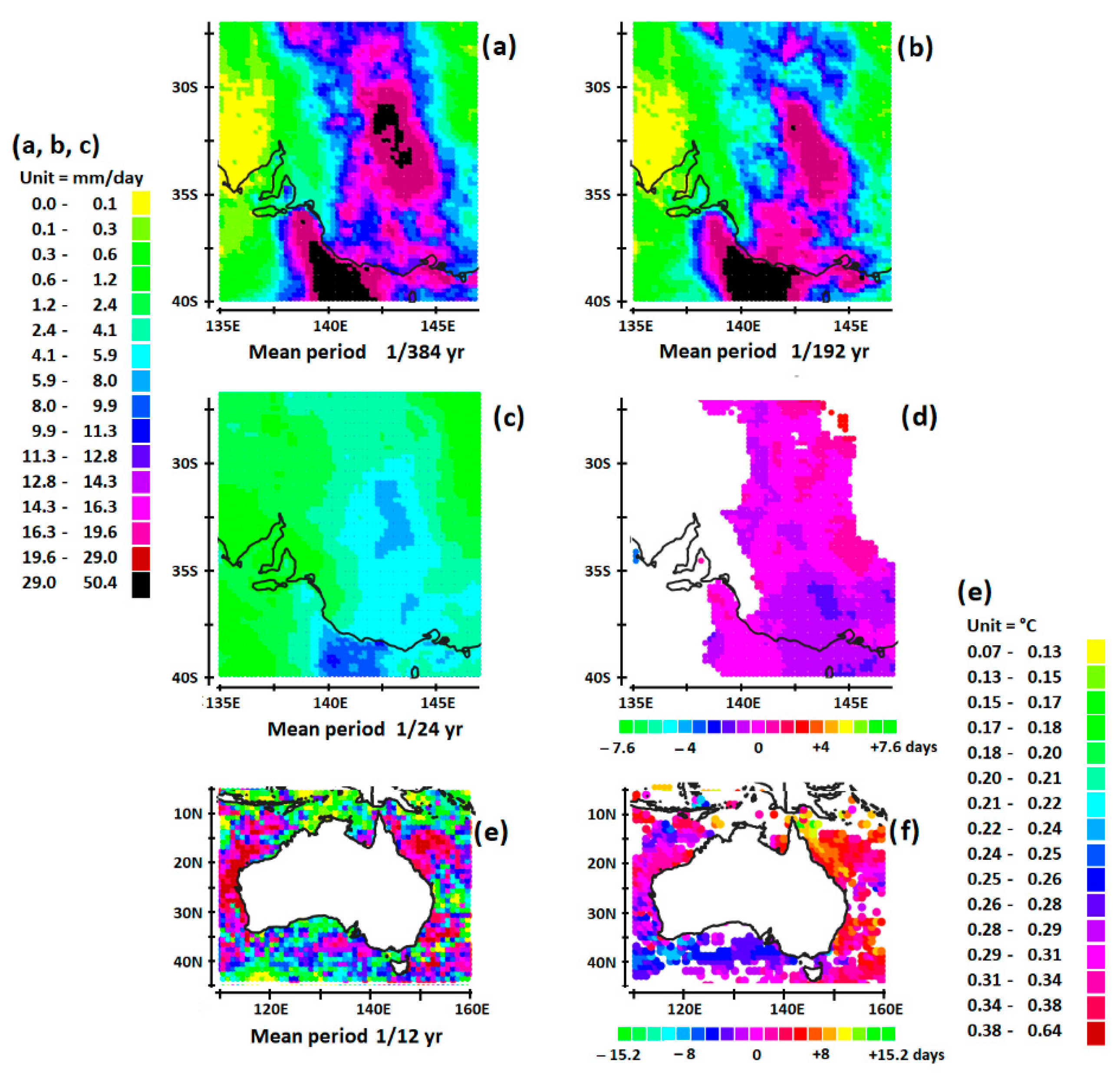

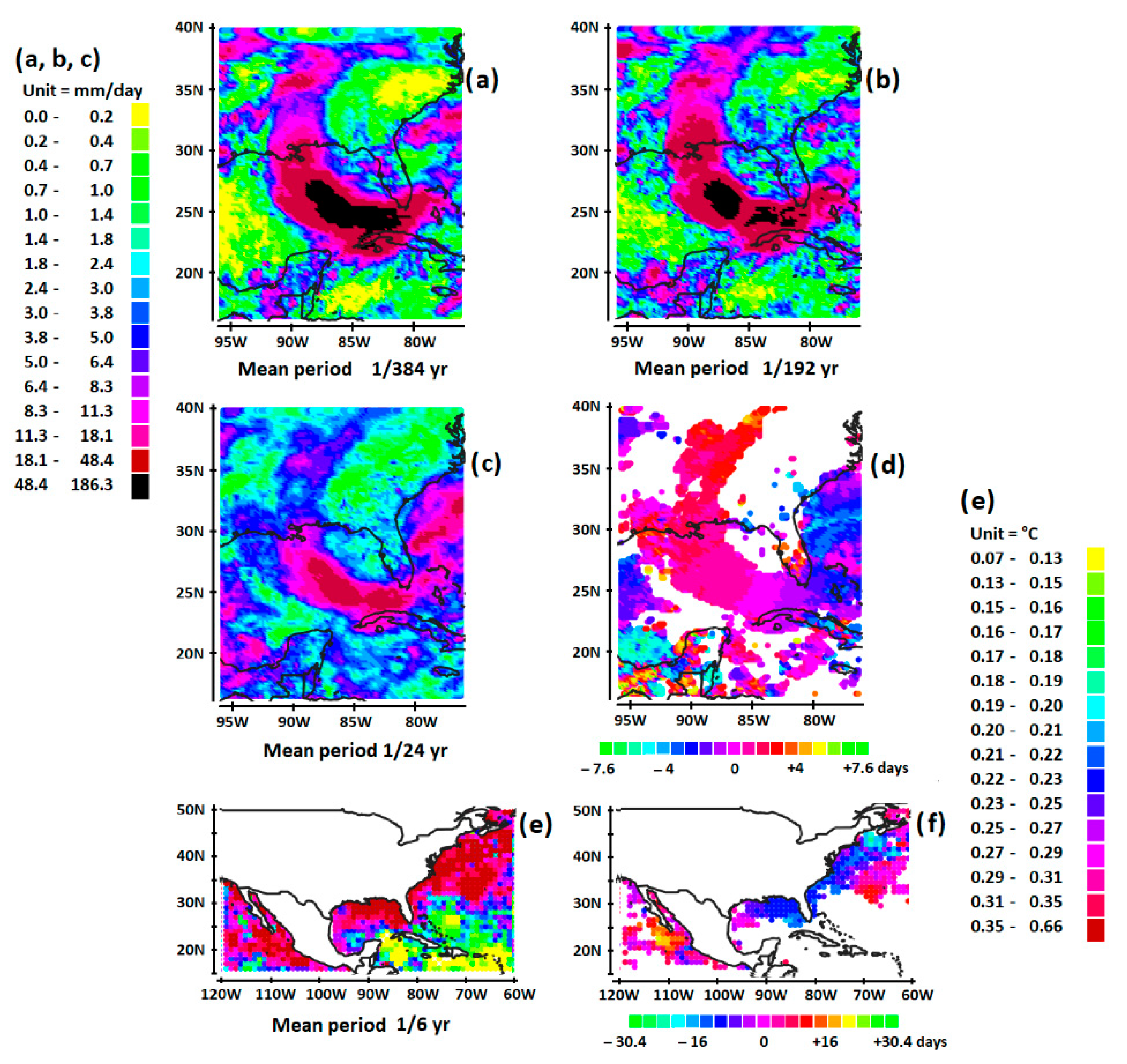
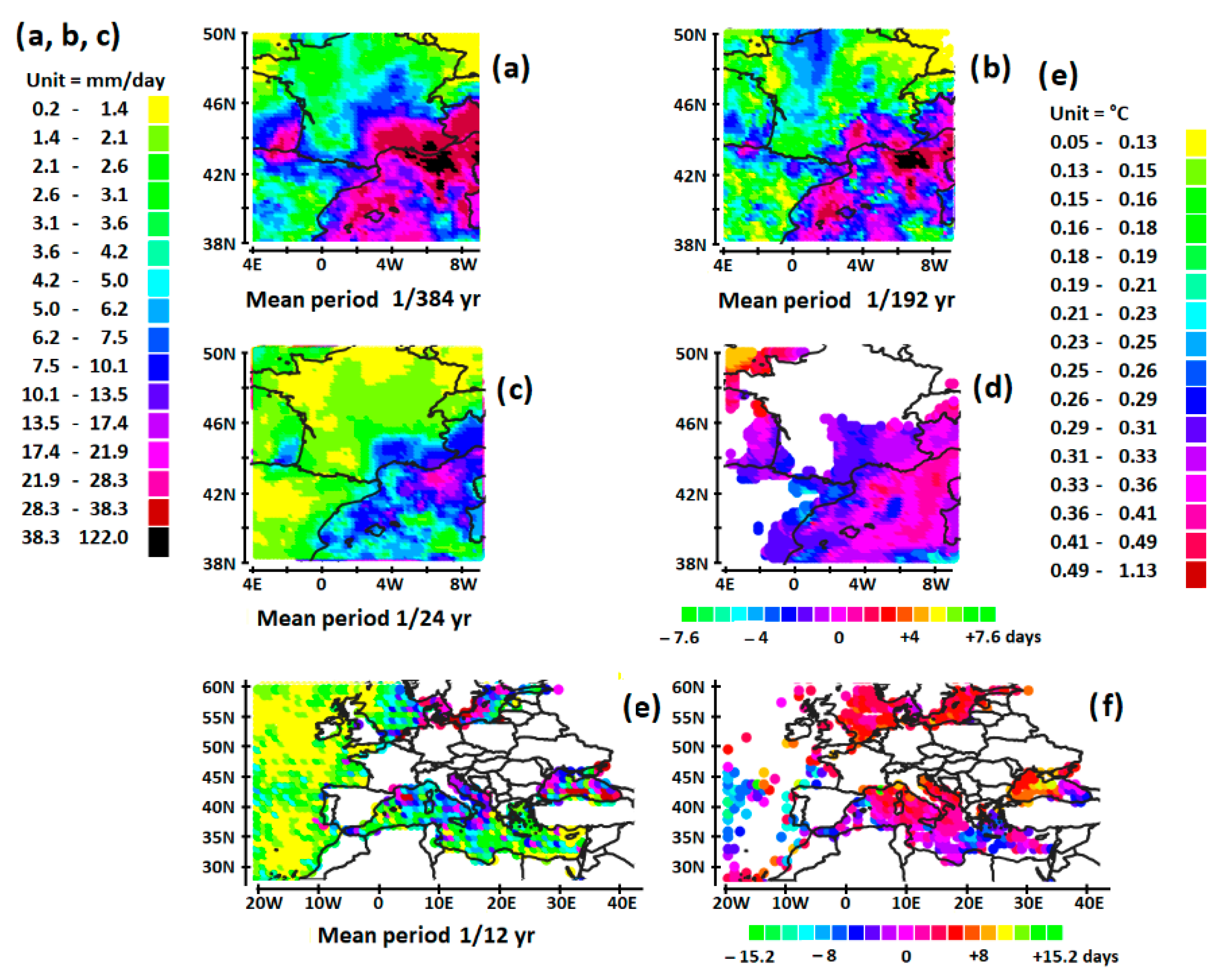
| Harmonic | Mean Period (days) | Lower Limit (Days) | Upper Limit (Days) |
|---|---|---|---|
| 1/6 | 60.9 | 45.7 | 91.3 |
| 1/12 | 30.4 | 22.8 | 45.7 |
| 1/24 | 15.2 | 11.4 | 22.8 |
| 1/48 | 7.6 | 5.7 | 11.4 |
| 1/96 | 3.8 | 2.9 | 5.7 |
| 1/192 | 1.9 | 1.43 | 2.9 |
| 1/384 | 0.95 | 0.71 | 1.43 |
Disclaimer/Publisher’s Note: The statements, opinions and data contained in all publications are solely those of the individual author(s) and contributor(s) and not of MDPI and/or the editor(s). MDPI and/or the editor(s) disclaim responsibility for any injury to people or property resulting from any ideas, methods, instructions or products referred to in the content. |
© 2023 by the author. Licensee MDPI, Basel, Switzerland. This article is an open access article distributed under the terms and conditions of the Creative Commons Attribution (CC BY) license (https://creativecommons.org/licenses/by/4.0/).
Share and Cite
Pinault, J.-L. Extreme Heavy Rainfall Events at Mid-Latitudes as the Outcome of a Slow Quasi-Resonant Ocean—Atmosphere Interaction: 10 Case Studies. J. Mar. Sci. Eng. 2023, 11, 359. https://doi.org/10.3390/jmse11020359
Pinault J-L. Extreme Heavy Rainfall Events at Mid-Latitudes as the Outcome of a Slow Quasi-Resonant Ocean—Atmosphere Interaction: 10 Case Studies. Journal of Marine Science and Engineering. 2023; 11(2):359. https://doi.org/10.3390/jmse11020359
Chicago/Turabian StylePinault, Jean-Louis. 2023. "Extreme Heavy Rainfall Events at Mid-Latitudes as the Outcome of a Slow Quasi-Resonant Ocean—Atmosphere Interaction: 10 Case Studies" Journal of Marine Science and Engineering 11, no. 2: 359. https://doi.org/10.3390/jmse11020359






